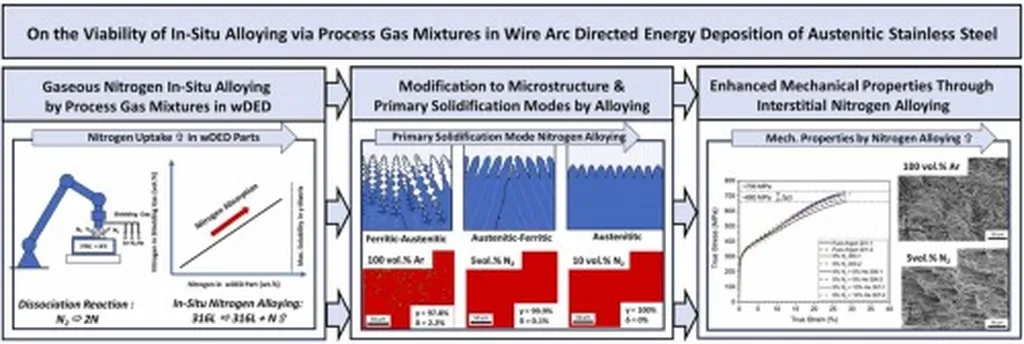In the ever-evolving landscape of additive manufacturing, a recent study published in *Materials Research Letters* has shed new light on the intricate dance of atoms that determines the final properties of 304L stainless steel produced by Laser Powder Bed Fusion (L-PBF). The research, led by Dr. C. Sofras from the Laboratory for Neutron Scattering and Imaging at the Paul Scherrer Institute in Switzerland, reveals how subtle variations in powder composition can dramatically alter the microstructure of the final product, even when processing parameters remain unchanged.
At the heart of this study lies the fascinating world of solidification modes. Dr. Sofras and his team discovered that the choice of atomization gas—nitrogen (N) or argon (Ar)—used during powder production induces distinct solidification pathways, ultimately shaping the material’s microstructure. “We found that N-atomized powder forms textured, columnar grains with elemental segregation, solidifying primarily as γ-austenite with secondary ferrite,” explains Dr. Sofras. “In stark contrast, Ar-atomized powder produces equiaxed grains with a uniform composition, following a primary ferrite to secondary γ-austenite mode.”
The implications of these findings are profound, particularly for the energy sector, where austenitic stainless steels are widely used due to their excellent corrosion resistance and mechanical properties. By understanding and controlling the solidification mode, manufacturers can tailor the microstructure of these steels to meet specific application requirements, enhancing performance and longevity.
The study employed operando synchrotron X-ray diffraction during L-PBF to reveal the real-time evolution of the microstructure. This cutting-edge technique provided unprecedented insights into the solidification process, underscoring the critical role of solidification control in tailoring the properties of austenitic stainless steels.
As Dr. Sofras notes, “Our research highlights the importance of considering both the powder composition and the solidification mode when optimizing L-PBF processes. This knowledge can guide the development of new alloys and processing strategies, ultimately driving innovation in the energy sector and beyond.”
The study’s findings are a testament to the power of fundamental research in driving technological advancements. By unraveling the complexities of solidification pathways, Dr. Sofras and his team have opened new avenues for innovation in additive manufacturing, paving the way for the development of high-performance materials tailored to the unique demands of the energy sector.
In the words of Dr. Sofras, “This research is just the beginning. As we continue to explore the intricacies of solidification control, we anticipate even more exciting discoveries that will shape the future of additive manufacturing and the energy sector.”
As the energy sector continues to evolve, the insights gained from this study will undoubtedly play a pivotal role in shaping the development of next-generation materials, driving innovation and progress in this critical field.

